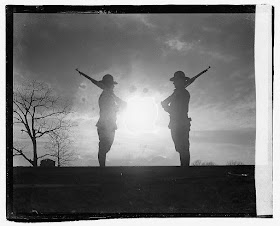The federal government
acquired the Belvoir
Peninsula in 1910 with
plans to develop the area into a reformatory.
Local citizens banded together with patriotic organizations such as the
Daughters of the American Revolution and the Mount Vernon Ladies’ Association
in opposing the establishment of a reformatory so close to Mount Vernon. The reformatory idea was scrapped and
Congress transferred the property to the War Department in 1912, following a
request by the U.S.
Army's Engineer School to use the area as a training
site. The Army’s Engineer School,
located in Washington,
needed field training areas and rifle ranges.
The Belvoir
Peninsula provided
challenging terrain where soldiers could build pontoon bridges and conduct
rifle practice.
America entered World War I in
April, 1917. In January 1918,
camp A.A.
Humphreys, named after Union Civil War General and former Chief of Engineer
Corps Andrew A. Humphreys, was established on the
Belvoir Peninsula. Within only four months of the start of
construction, Camp A.A. Humphreys was in operation.
Over the course of eleven months, extensive
camp facilities were constructed, with most of the heavy labor being done by segregated
African-American service battalions. To
accommodate the twenty thousand troops who were to use the camp, seven hundred
and ninety temporary wood-frame buildings were constructed. A newly constructed
dam across Accotink Creek and a water filtration plant assured a steady flow of
fresh water. Transportation systems and
utilities were also improved. The
unpaved
Washington-Richmond
Highway was surfaced in concrete within six months
and a plank road was built linking the camp to the Highway. Standard gauge and
narrow gauge railways followed. Building these transportation systems
facilitated deliveries to the camp, and provided engineer training experience
for troops being sent to
Europe. During 1918,
some sixty thousand troops received training in engineering, trench warfare,
and gas warfare. After the war Camp A.A.
Humphreys became a permanent installation and was renamed
Fort Belvoir
in the 1930s.


No comments:
Post a Comment